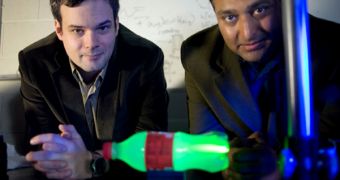Experts at the Massachusetts Institute of Technology (MIT) announce the development of a new imaging system that is capable of capturing video at a rate of one trillion frames per second. The device is capable of imaging light as it travels through a bottle.
As the video embedded at the end of this article will confirm, the imaging system is even able to see how light bounces off from the bottle's cap, and is then reflected back through the liquid. The innovative technology has countless potential applications.
According to researchers who developed the camera, there is literally nothing in the Universe that moves or looks too fast for this camera. It represents a nearly-absolute ultimate as far as slow-motion technologies go, the team says.
Andreas Velten, a postdoctoral researcher at the MIT Media Lab, developed the new imaging system together with associate professor Ramesh Raskar. The camera is made up of an array of 500 photo sensors, while the light source if a femtosecond titanium-sapphire laser.
A femtosecond laser produces pulses of light that only last for a few femtoseconds. A femtosecond is a unit of time equal to one quadrillionth – or one millionth of one billionth – of a second. The MIT streak camera can see even these ultra-fast photons beams in slow motion.
One of the most interesting potential applications for the new technology could be in medical imaging, where sound waves could be replaced with photons. Light diffraction patterns can be analyzed in just the same way as currently possible with sound.
However, using photons will enable doctors to become more precise in their diagnostic, since the capabilities on the new imaging devices will far exceed anything available today, in terms of performances.
At this time, the system is only in its infancy, since it only produced unidimensional views at first. The experiment needs to be repeated many times in order for a 2D view of a particular scene to be reconstructed. This is currently an obstacle for wider-scale applications.
However, MIT researchers are convinced that they will be able to make the system work faster and better in the near future. Their work will not be easy, they admit, especially when considering that it takes only a nanosecond for light to scatter through a bottle containing liquid.
“As photons bounce around in the scene or inside objects, they lose coherence. Only an incoherent detection method like ours can see those photons,” Velten concludes.

 14 DAY TRIAL //
14 DAY TRIAL // 